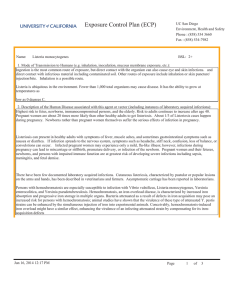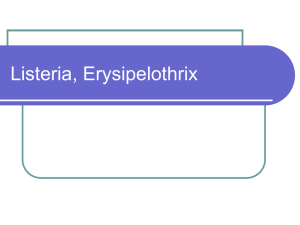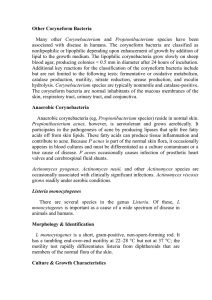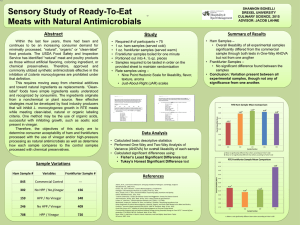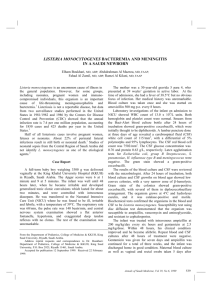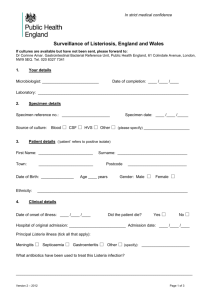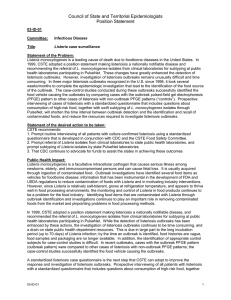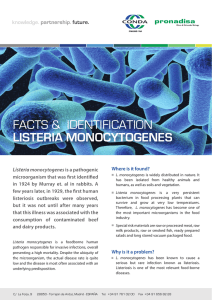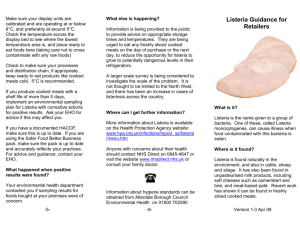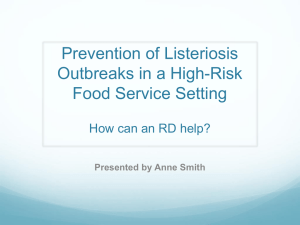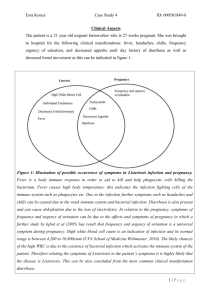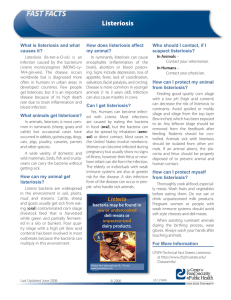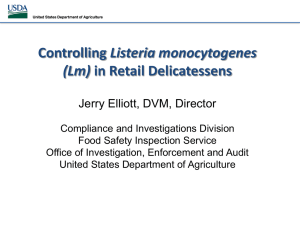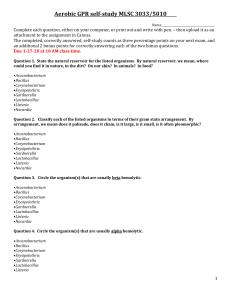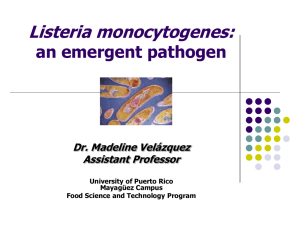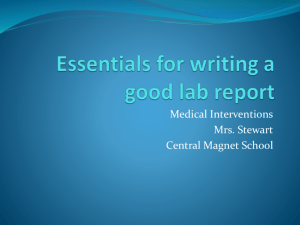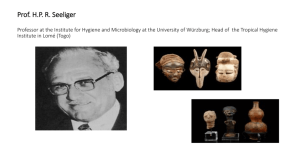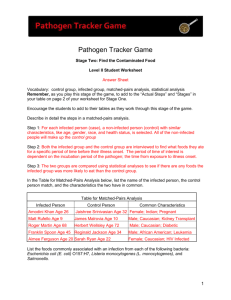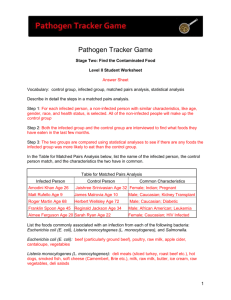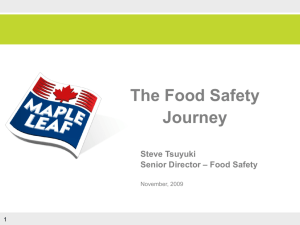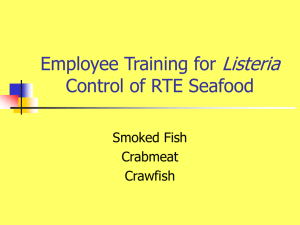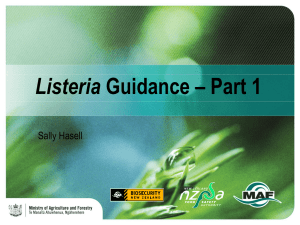Listeria monocytogenes
advertisement
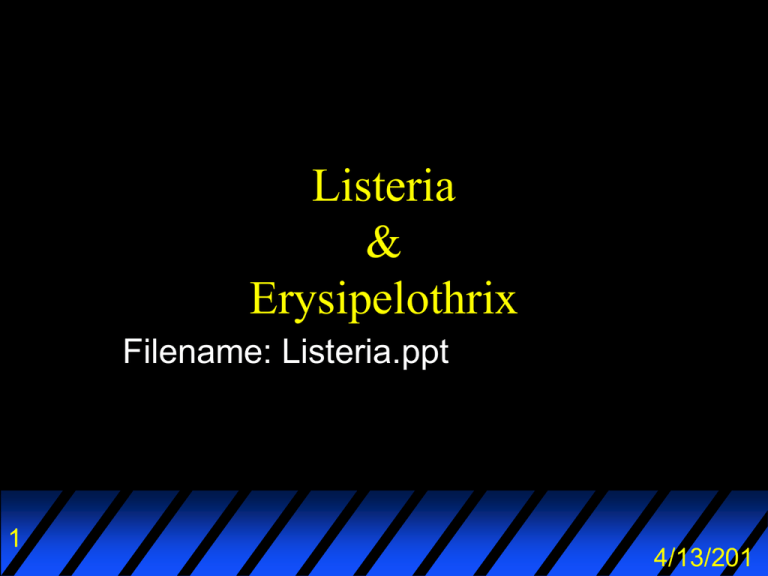
Listeria & Erysipelothrix Filename: Listeria.ppt 1 4/13/201 Outline Microbes – Corynebacterium,Listeria, Erysipelothrix Diseases – Diphtheria,Listeriosis, Erysipeloid 2 4/13/201 Listeriosis 3 4/13/201 Listeria monocytogenes short , motile,non-spore - forming, Grm + rods, - hemolytic, looks like Group B streptococcus but group B is catalase neg and non-motile. found in wild and domestic animals excreted into soils healthy human carriers 5-10 % source of infection is food and animal contact. 4 4/13/201 Listeria Infections Neonatal sepsis or meningitis Spontaneous abortion or still birth Sepsis or meningitis in immunocompromised patients Puerperal sepsis Persons at risk: Pregnant, post partum, new born, organ transplants 5 4/13/201 Listeriosis Disease of humans – Sepsis – Meningitis + encephalitis 25% 6 mortality 4/13/201 Listeria Pathogenesis Ingested raw contaminated food Penetrates cell of intestine common event most have T cells Facultative intracellular pathogen Immunocompromised host Transmitted congenitally 7 4/13/201 Listeriosis Diagnosis Monocytosis – Peripheral blood & cerebrospinal fluid Gram stain – Gram positive rods in CFS Culture – Blood, CSF, skin lesions 8 4/13/201 Listeria: Virulence Factors Internalin an invasion factor controlled by the inl A gene The organisms are taken into the cell by forced phagocytosis, become enclosed in a vesicle and rupture it. Listeriolysin - alpha hemolysis hly gene. Lecithinase - hemolysin Phospholipase 9 4/13/201 Listeria: Food poisoning MILK and dairy products. This species grows at refrigerator temp. 5-12o C Isolated by cold enrichment. 10 4/13/201 Test for Listeria in Milk Add fluorescent-labelled antibodies specific for Listeria monocytogenes to milk Pass through a flow cytometer. fluid is passed through a small opening Listeria detected by a laser beam NO CULTURE NEEDED!!! 11 4/13/201 Listeriosis Prevention Persons at risk avoid soft cheeses and unpasteurized milk and processed meat that cannot be cooked. thoroughly cook all meats especially hot dogs – left over meat should be cooked to steaming. 12 4/13/201 Listeriosis Control Hygienic food processing – contaminated vegetables – vinegar in salads Antimicrobial agents – Not cephalosporins – Ampicllin + aminoglycoside – bacteriostatic 13 4/13/201 Erysipeloid 14 4/13/201 Erysipelothrix pathogenesis Skin lesions – fingers or hand – violet or wine coloured Occasionally septicemia – endocarditis – afebrile arthritis 15 4/13/201 Erysipelothrix rhusiopathiae Gram positive rods Grow aerobically – prefer 7% carbon dioxide Non motile Non hemolytic Produce hydrogen sulfide 16 4/13/201 Erysipelothrix Epidemiology Found in mammals, poultry & fish Farmers, vets, slaughterhouse workers, fish handlers 17 4/13/201 Erysipelothrix Diagnosis & Control Diagnosis – Typical lesions – Occupation – Blood culture if sepsis Control – Self limiting – Penicillin if complications 18 4/13/201 The End 19 4/13/201 Performance Objectives Key terms, concepts short answers 20 4/13/201 Key Terms 21 4/13/201 Key Terms 22 4/13/201 Key Organisms Corynebacterium Listeria Erysipelothrix 23 4/13/201 Key Concepts 24 4/13/201 Epidemiology of Listeriosis Disease/bacterial factors Transmission Who is at risk Geography/ season Incidence Modes of control 25 4/13/201 Short Answers Construct a table of the virulence factors associated with listeriosis and the biological activity of each Describe the clinical manifestations of listeriosis Construct a table listing the common Corynebacteria and the associated diseases. 26 4/13/201
